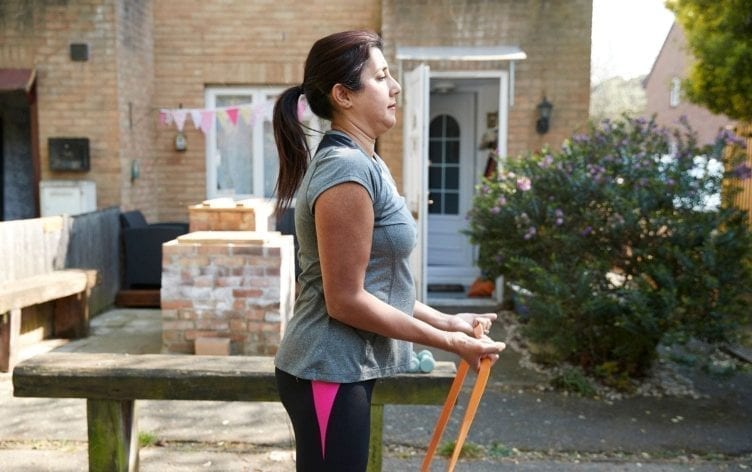
Low-impact workouts boast a ton of benefits, from healthier joints to a lower risk of injury. But there’s something about the term “low-impact” that makes people associate it with “low-intensity.”
“Often, clients tend to be persuaded away from taking a lower-impact class because they feel as if it won’t be challenging,” explains Anthony Crouchelli, a certified strength and conditioning specialist. But low impact doesn’t automatically mean low intensity. Low impact just means there are no hopping or jumping motions, Crouchelli says. In fact, it’s common for workouts to be high intensity yet low impact.
So, how can you ensure you get the most out of your low-impact sessions if you want to be sure to work up a sweat and raise your heart rate? Here’s what expert trainers recommend:
1
PLAY WITH YOUR PACE
“Speed drives the intensity of a workout, so faster reps make for a faster heart rate and more calories burned,” explains Evan Lawrence, a certified personal trainer.
Another option is to slow way down, says Celestine Atalie, a trainer at P.volve. For instance, imagine doing a pushup as slowly as you can. Often, this is significantly more difficult than doing an exercise at your normal pace.
2
ADD WEIGHT
“Adding weight to exercises to make them more intense is a great way to up the ante in a low-impact workout,” says Leighanne Stephens, a certified personal trainer. For example, you could grab a kettlebell to add to squats or lunges or add a weighted vest or ankle weights to your walking routine.
3
TRY CARDIO INTERVALS
If you really love to get your heart rate up and endorphins flowing, but are trying to stay away from bootcamp-style workouts (which often involve high-impact moves like burpees and high knees), you can re-create a similar effect using a cardio machine like a stationary bike or elliptical by doing interval work.
“Decide on a duration and ratio for your intervals,” instructs Craig Salmon, a master personal trainer and master tutor at Premier Global NASM. “For example, you might do 10 rounds of 30 seconds on followed by 1-minute recovery for a total of 15 minutes. For high-intensity interval training (HIIT) to be effective, the ‘on’ periods have to be at 100% effort, followed by recovery periods where you are still moving but able to somewhat bring heart rate and breathing back down.”
4
BAND IT
“Resistance bands and resistance loops are inexpensive and are a great way to add intensity to simple movements, without ramping up the impact,” says Tami Smith, a certified personal trainer. For instance, you can ramp up your squats by adding a resistance loop around your thighs. “It will help recruit more muscle fibers and allow your muscles to work harder as you’re working against your own body weight plus the resistance of the band.”
5
REST LESS
“To get your heart rate up to those higher zones while completing a lower-impact workout, don’t allow it to go back down between sets or rounds,” advises Salmon. This may mean simply taking shorter breaks between exercises. Another option: Use supersets, where you combine two strength exercises, immediately switching to the other once your set of the first exercise is finished. After this, you take a short break, then get right back into it.
6
INCORPORATE COMPOUND MOVEMENTS
“Compound movements simply mean working more than one muscle group at the same time,” explains Paul Scianna, a certified personal trainer and professional boxer. This boosts your heart rate and increases demand on your body overall. For instance, you might do dumbbell thrusters, which combine a front squat with an overhead press. Many common strength-training exercises also qualify as compound movements, such as deadlifts, squats, pullups and bench presses.
7
FOCUS ON THE MIND-MUSCLE CONNECTION
“The most effective way to increase the intensity of training is to improve the mind-muscle connection,” says Kathryn Alexander, MEd, a personal trainer. How does it work? “When you become skilled at using the muscles and muscle groups you intend to instead of just bopping through the movement, you’ll get much more deliberate and targeted work out of your training.”
8
TRY AN ASYMMETRICAL MOVE
“If you’re looking to make a low-impact workout more intense, try working one side of your body at a time,” suggests Jenell Riesner, a certified personal trainer. These movements are also known as unilateral exercises. “Focus on activating your core to prevent your body from rotating to the side that is working,” Risener says. “Not only will the workout feel more intense, but you get the added benefit of extra core work.”
9
ADD A PULSE OR A PAUSE
There’s no need to jump around to fatigue your muscles. Here’s an easy swap to make any high-impact workout low impact: “Add in a pulse or pause at the bottom of an exercise to increase your time under tension and thereby ramp up the burn and intensity of the movement,” Smith recommends. So jump squats become squats with a pulse at the bottom, and jumping lunges become dead-stop lunges, with a complete pause at the bottom.
10
WORK YOUR ANGLES
There are three different planes we can exercise in:
- Sagittal (forward and back)
- Frontal (side to side)
- Transverse (rotational)
“A lot of traditional movements are done on the sagittal plane,” Reisner says. Her advice? “Try mixing up your movements by working side to side or even adding rotation to what you’re doing. For example, a lunge is a sagittal movement, but you can add a twist over the front leg to challenge your balance, engage your core, and work in the transverse plane as well.”
https://www.leighannesfitness.co.uk/
Tagsexpert adviceFitness Tipslow impactWorkouts